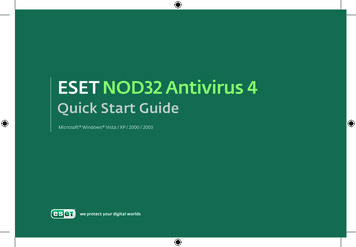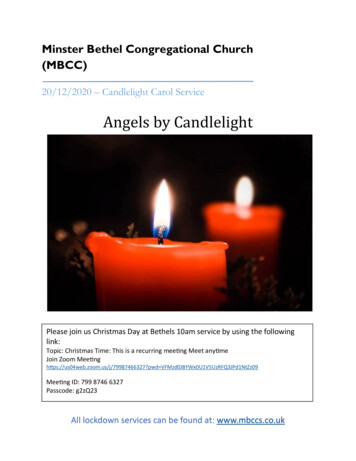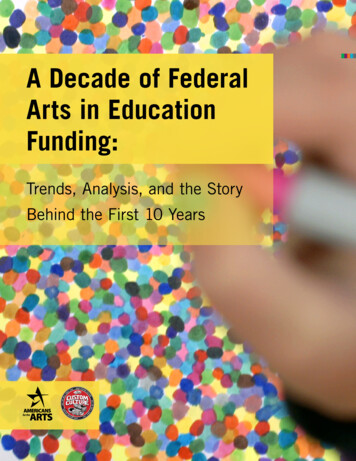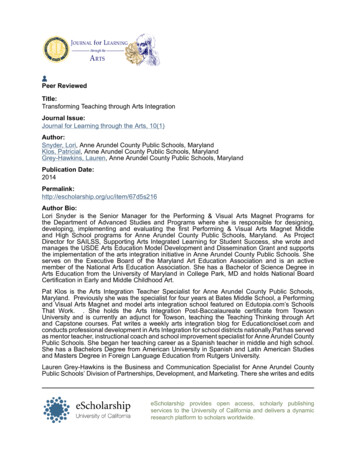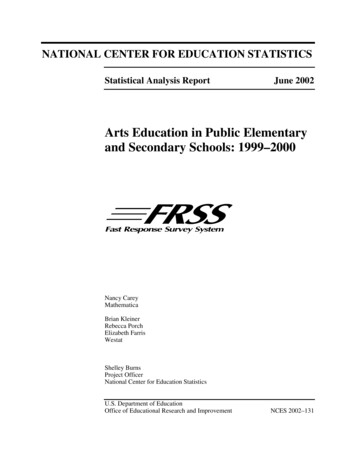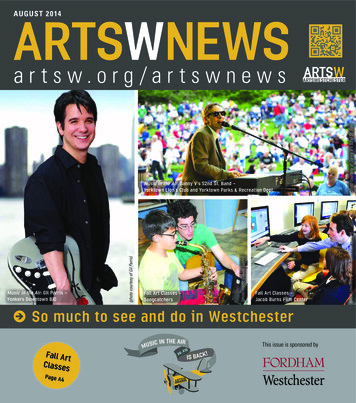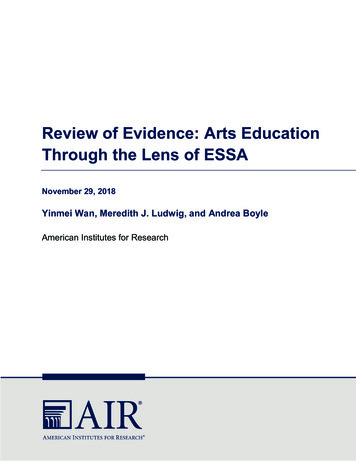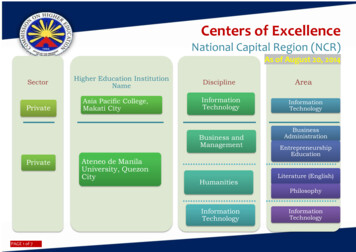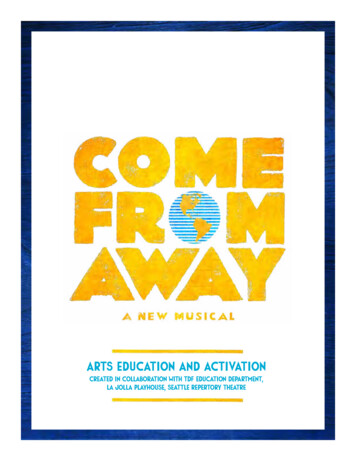
Transcription
Arts education and activationCreated in Collaboration With Tdf Education Department,La Jolla Playhouse, Seattle Repertory Theatre
F R O M DAV I D A N D I R E N EHello,Welcome to the Rock!When we traveled to Newfoundland in September 2011 on the tenth anniversaryof 9/11, we had no idea that our journey would bring us to Broadway.We spent a month in Gander, Newfoundland and the surrounding communities meetingwith the locals, returning flight crews and pilots, and returning “come from aways”(a Newfoundland term for a visitor from beyond the island) who gathered to celebratethe hope that emerged from tragedy.We didn’t know what we were looking for, but thankfully the people of Newfoundlandare incredible storytellers. As we heard numerous tales of ordinary people andextraordinary generosity, it became clear that during the week of 9/11, for the 7,000stranded passengers and people of Newfoundland, the island was a safe harborin a world thrown into chaos.We laughed, we cried, we were invited over for dinner and offered cars. We madelifetime friends out of strangers and we came home wanting to share every storywe heard – about 16,000 of them!Through this journey, we’ve learned it’s important to tell stories about welcomingstrangers and stories of kindness. It’s important to honor what was lost andcommemorate what was found.Thank you for joining us on this journey and adding your story.David Hein and Irene Sankoff2
HOW TO USE THIS GUIDEThematic Action: Examining and thinking about empathyWe are so excited to share COME FROM AWAY with you and your students!We invite you to learn more about the history of the production, the realevents that inspired the production and engage in classroom activitiesthat examine empathy.This guide is intentionally designed to be a flexible teaching tool for teachersand facilitators. The guide can be explored in its entirety, or in a selected seriesof activations* that address curriculum needs and time constraints.The Guide is broken up into three sections:I. GETTING TO KNOW NEWFOUNDLANDStudents are invited to witness the oral histories of friends andfamily members and explore communication.II. COME FROM AWAY HISTORICAL CONTEXTStudents are invited to be witnesses to the oral histories of those in theirlives and explore communication in crisis as they learn more aboutOperation Yellow Ribbon and the surrounding events in the United States.III. 9/12 AND BEYONDStudents learn about the aftermath while reflecting on the powerof kindness and empathy and exploring ways to “pay it forward.”*A Note on ActivationsActivations are meant to take students from the realm of knowing a thing orfact into the realm of thinking and feeling. Activations can be very sophisticated,or simple, depending on the depth of exploration teachers and facilitators wantto do with their students, or the age group they are working with.Grade LevelActivations are recommended for Middle School and High School students.Grade Level adjustments noted where appropriate.3
SECTION 1Getting to Know NewfoundlandMAKING A MUSICALHow does the story of Gander, Newfoundland on September 11, 2001 transform into a new musical? That is where DavidHein and Irene Sankoff, Canadian husband-and-wife writing team, enter. In 2010, they wrote and performed in their firstshow together, My Mother’s Lesbian Jewish Wiccan Wedding . It was the hit of the Toronto Fringe Festival and it was laterpicked up by Mirvish Productions for an extended run. Michael Rubinoff, who later founded the Canadian Musical TheatreProject and is the Associate Dean at Toronto’s Sheridan College, attended a performance of MMLJWW . Impressed with thecouple’s work, he presented the idea for a new show: the story about how a small Newfoundland community welcomed7,000 passengers on 38 planes that were diverted to their town on 9/11.David and Irene are the perfect authors for this musical, having connections to both Canada and the United States.Not only are they Canadian writers, but David also holds dual citizenship and the couple lived in New York during 9/11. Theyrecognized this story as one not about 9/11, but set against that backdrop. David and Irene traveled to Newfoundland inSeptember 2011 for the 10th anniversary commemorating the pilots and “Plane People” that had returned to Gander.There, they gathered interviews with everyone they met and experienced the Newfoundlander’s generosity.From here, they sorted through the interviews, documentaries, and letters from around the world. This surplus ofmaterial needed to be streamlined. The playwrights asked themselves, “What is the story? What is the through line?”In 2012, the couple was invited to workshop the show for the inaugural year of the Canadian Music Theatre Project at SheridanCollege. They presented 45 minutes of material, essentially the first half of the show. Fourteen student actors played over100 characters, and sang the music from Newfoundland and around the world.The musical journeyed to the National Alliance of Musical Theatre Festival in New York in 2013. David and Irene madeconnections with major regional theatres across the country, including La Jolla Playhouse. Christopher Ashley, director,joined the team and a co-production with Seattle Repertory Theatre was created. COME FROM AWAY then traveled toFord’s Theatre in Washington, DC and the Royal Alexandra Theatre in Toronto before landing on Broadway. The cast of theshow has been cut down to twelve and the stories consolidated into one act. It has musically expanded to an eight-pieceband. With this musical, the couple hopes the audience will be inspired by these stories and music from Newfoundland,just as they were.4
HISTORYGander was chosen for the construction of an airport in 1935 because of its location closeto the northeastern tip of North America. In 1936, workers began clearing land, boastingone square mile of tarmac. Captain Douglas Fraser made the first landing at “NewfoundlandAirport” now known as Gander International Airport on January 11, 1938. With the onsetof WWII, as many as 12,000 British, Canadian and American servicemen lived in crowdedbarracks beside and between the runways. Gander became a strategic post for the RoyalAir Force Ferry command. After the war, efforts were made to move residents a saferdistance away from the runways. Construction began in the 1950s on the current town site.During the post-war/Cold War era, Gander emerged as the hub of commercial transatlanticaviation, gaining the name the “Crossroads of the World.”CULTUREAs a result of its international heritage, Gander’s residents include individuals and familiesfrom countries on five different continents. Gander is primarily an English-speaking community,though many residents also speak French. Warm and friendly, the people of Gander arefamous for their hospitality. Newfoundland and Labrador was named one of the top 10friendliest cultures in the world according to Macleans magazine. The community treatsnon-Newfoundlanders (known to Newfoundlanders as “come from aways”) as family. VisitGander, and you might find yourself involved in a screech-in ceremony. During this initiationto Newfoundland, outsiders take a shot of screech (Newfoundland rum), perform a shortrecitation, and kiss a codfish.BRAINSTORM IT!Think of a story that you think would make a great musical.This story can be about a personal experience, a historicalmoment or a fictional character. Why do you think this story would make a great musical? How will music enhance the telling of this story? What characters would be central to the story?5
GeographicallocationGander lies in the northeastern tipof the island of Newfoundland in theprovince of Newfoundland and LabradorLABRADORNEWFOUNDLANDGANDERCANADAUNITED STATES6
How do people make money in Gander?Residents of Gander make money by working in these main industries: TransportationBus Driver or Air Traffic Controller CommunicationsLocal TV Reporter Public Administration and DefenseMayor or an administrator for the Gander governmentFUN FACTSHow many peoplelive in Gander?12,732 At the time of its completion in 1938, the then ‘Newfoundland Airport’ was the largest airfieldon the planet, with four huge paved runways. These tarmacs equaled one square mile.Today the world’s largest airport is the King Fahd International Airport in Saudi Arabiawith a land area of 301 square miles. In St. John’s Newfoundland, you can find moose wandering about.Because of this, residents advise tourists not to drive on the highway at night. A crater on the surface of Mars has been named for the town of Gander, in recognitionof the airport town’s history of pioneering aviation and aerospace technologies.Further investigation What does “Crossroads of the World” mean? What other places are “Crossroads of the World?” Why or how do people end up in different placesor countries?7
Activation #1CREATING THE MUSICAL POEM1. Have each student write one line that describes how they feel about the place they identifyas “home.” Home is where they are from, where they live, or a place that has an influence onthem as an individual.EXAMPLE In South Korea, I felt the loneliness of missing family holidays at home in Massachusetts. New York is my best friend and nemesis. Walking through the old gates and roads, being greeted by a sense of familiarity in Greece.2. Gather students into a standing circle, and go around and have each student recitetheir line. Try and find a natural rhythm to the recitation.3. Have students reflect on what they heard.4. Have students listen to “38 Planes” from COME FROM AWAY.REFLECT ON THE SONG How did the music enhance the song? How does music communicate emotion, or convey what words can’t?5. Have students re-visit their circle poem and create a beat by snapping or clapping. (If youwant to be more advanced, add a chorus, or musical instrumentation)Allow time for everyone to get the beat.6. Go around the circle, repeating step 2, while everyone keeps the beat.REFLECT What was different with the addition of music? How did the music enhance the poem? How does music communicate emotion,or convey what words can’t? How might this musical poem differ if other actorsor classmates were doing it?8
Activation #2SCRIPT CONNECTION / POST SHOW REFLECTIONHave students examine this scene from COME FROM AWAY:ALLON THE EDGE OF THE WORLD OR WHEREVER WE AREWE ARE – WE ARE – WE ARE ON THE EDGEIS THERE SOMETHING - I NEED TO DO SOMETHINGTO KEEP ME FROM THINKING OF ALL OF THOSE SCENES ON THE TUBEI NEED SOMETHING TO DO – CAUSE I CAN’T WATCH THE NEWSNO I CAN’T WATCH THE NEWS ANYMOREALLON THE EDGECLAUDEFAA KEEPS DELAYING OPENING THE AIRSPACE – AND HERE ON THEGROUND, WE’RE DEALING WITH A WHOLE MESS OF OTHER PROBLEMSALLON THE EDGE OF THEBEVERLEYSOME OF THE PLANES ARE PARKED ON A RUNWAY WHERE THE SURFACE ISALL TORN UP. THAT DEBRIS GETS INTO AN ENGINE AND THEY’LL NEVER LEAVE.ALLON THE EDGE OF THE WORLDREFLECT How did repetition of the phrase “On the Edge of theWorld” enhance the meaning of the song? Why would you intersperse dialogue and song? What other examples can you find throughout the showof this happening?9
Going FurtherSONGS SHARE STORIES OF HOME, CULTURE AND COMMUNITY. EXAMINE THIS TRADITIONALNEWFOUNDLAND AND LABRADOR FOLK BALLAD TO LEARN MORE ABOUT THIS UNIQUECOMMUNITY.“JACK WAS EVERY INCH A SAILOR”VERSE 1 :‘Twas twenty-five or thirty years since Jack first saw the light,He came into this world of woe one dark and stormy night;He was born on board his father’s ship as she was lying to,‘Bout twenty-five or thirty miles southeast of Baccalieu.CHORUS :Oh, Jack was every inch a sailor,Five and twenty years a whaler;Jack was every inch a sailor,He was born upon the bright blue sea.VERSE 2 :When Jack grew up to be a man he went to the Labrador,He fished in Indian Harbour where his father fished before;On his returning in the fog he met a heavy gale,And Jack was swept into the sea and swallowed by a whale.CHORUSVERSE 3 :Oh, the whale went straight for Baffin Bay, ‘bout ninety knots an hour,And every time he’d blow a spray he’d send it in a shower;Oh, now, says Jack unto himself, I must see what he’s about,He caught the whale all by the tail and turned him inside out.REFLECT What do you learn about Jack from this song? What do you learn about the Newfoundland and Labrador community from this song? What do you learn about the natural environment of Newfoundland and Labradorfrom this song? Look up the words and locations you do not recognize in this song. What do theseplaces and words tell you about Jack’s world? What places and unique words would you include in a song about your home? Does this song remind you of other stories? Why do you think this story is sung?10
HOW TO SPEAK LIKE A NEWFOUNDLANDERTHIS REMOTE COMMUNITY HAS A COLORFUL LANGUAGE ALL ITS OWN.SOME OF OUR FAVORITE WORDS AND PHRASES ARE BELOWCOMEFROMAWAYA traveler toNewfoundland - someonewho wasn’t born thereCOME ON, WE GO’SLet’s goSTUNNEDSWEET JESUS INTHE GARDEN!STAY WHERE YOU’RE TO ‘TILLI COMES WHERE YOU’RE ATAn expletiveYES, B’YStay there untilI get thereHAVING A TIMEWHERE Y’LONGS TO?WHO KNIT YA’?Enjoying yourselfHaving a party.Where do youcome from?Who’s your mother/parents?HE/SHE’S GOT ENOUGH MOUTHON HER FOR THREE LIPSHe/She won’t stoptalking/is a big gossipDinner anda dance.May youhave goodfortune.A thingamajigNOT FITBUDDYWHASSISNAMEReally cold weather - imaginethe sound of chattering teethI DIES AT YOU‘OW’S SHE GETTING ON?It’s all gonewrong.CHUMMY JIGGERExceptionallybad weather.BIVVERIN’Good for any usein any instanceLONG MAY YOURBIG JIB DRAWTHE ARSE IS GONERIGHT OUT OF HERA SCOFF ANDA SCUFFReally stupid.Someone youcan’t rememberYou’re funnyLIKE A BIRCHBROOM IN THE FITSHow are you doing?Messy hairGOD LOVE YOUR COTTON SOCKSI’M GUTFOUNDERED,FIRE UP A SCOFFI’m hungry, makeme some foodThankyouPROPER THINGThey got what they deservedBEST KINDTo express satisfactionCROOKED AS SINBUDDY, B’W, M’SON,M’DARLING, M’LOVE,DUCKY, COCKY, TROUTReally grumpyNOW THE ONCEIn a minuteRIGHTSynonym for “very”-She’s rightpretty, It’s right cold outsideTerms ofendearment911
Activation #31. Have students partner and read through the “Newfinese” phrases,try them out on each other.2. As a group, brainstorm expressions unique to your home.3. Have students partner again and write a 20 line dialogue where they useat least 3 Newfinese phrases, and 3 phrases unique to them4. Have partners share out their dialogues with the class.REFLECT How did the phrases change the tone of the dialogue? Why do you think people speak differently in differentparts of the world?Script reflectionHave students read aloud this scene from COME FROM AWAYGWANDOYAThere are soldiers everywhere. I see the fear in my wife’s eyesALL (EXCEPT GARTH AND GWANDOYA)PANDE ZOTE SISIGWANDOYAThe man at the front opens the door.GARTHI say, “here you are. Out you go.” But he doesn’t understand.And he’s not getting off. None of them are.ALL (EXCEPT GARTH AND GWANDOYA)GIZA NA MITI(continued on pg. 13)12
GARTHBut then I notice that his wife is clutching a bible – well, I can’t read itobviously, but their bible – it’ll have the same number system ours does –so I ask to see it and I’m searching for something – and then in Philippians 4:6 –I give them their bible and I’m pointing and saying, look!“Philippians 4:6 – Be anxious for nothing. Be anxious for nothing.”GWANDOYAThat’s how we started speaking the same language.REFLECT Are there ways to communicate without language? Are there universal languages?Activation #41. Reimagine the scene, have students act out the brief scene,without using any words.2. How do you communicate without words?3. What qualities do you rely on?13
SECTION 2COME FROM AWAY HISTORICAL CONTEXT9/11: Foreign Terrorism on American SoilEverybody twenty-two and older with a connection to the US remembers exactly whatthey were doing when they heard the news of the terrorist attack on the World TradeCenter and, later that day, the Pentagon. September 11, 2001 was a day when many ofus started our routines, just like any other day, but were suddenly confronted with oneof the greatest tragedies in American history and a completely different view on the USand the world. 2,977 lives were lost in a matter of hours and our country’s culturallandscape changed forever. On the next page is a timeline of what happened indifferent parts of the country on that day, from 8am to 8pm.Pre-Activation #1:HAVE STUDENTS PLAY THE PART OF COME FROM AWAY CREATORS, DAVID HEINAND IRENE SANKOFF BY GATHERING STORIES ABOUT 9/11 FROM FAMILY MEMBERSAND FRIENDS TO SHARE WITH THEIR CLASSMATES.1. Students prepare a list of questions to prompt interview subjects to share their story.Questions can include: How did you start your day on September 11th, 2001? How did you end your day? Who did you interact with on 9/11? Were you at School? Work? How did members of your community support each other on 9/11 and afterward? How was your world different after 9/11?2. Before the class session, students interview subject and take careful notes. If possiblerecord interview session on cell phone or other recording device.3. During the class session, students sit in a circle and share a 1-2 minute portion oftheir interview subject’s story.REFLECT What made the interview difficult? Special? Surprising? What is your responsibility as the storyteller? How does the story you gathered fit with stories from your classmates? How is the story you gathered similar to or different from the storiesyour classmates shared?14
“The captain handed me a printed message. [It] simply said:‘ALL AIRWAYS OVER THE CONTINENTAL US ARE CLOSED.LAND ASAP AT THE NEAREST AIRPORT, ADVISE YOUR DESTINATION.’It was quickly decided that the nearest airport was 400 miles away,behind our right shoulder, in Gander, on the island of Newfoundland.- Nazim, Member of a Delta flight crewAN UNEXPECTED MORNINGTHE WORLD TURNS ITS ATTENTION7:59 AMAmerican Airlines Flight 11, with 92 people aboard,takes off from Boston’s Logan International Airport for Los Angeles.9:02 AMPort Authority officials broadcast orders to evacuate the South Towerof the World Trade Center.8:14 AMUnited Airlines Flight 175, with 65 people aboard,takes off from Boston, headed to Los Angeles.9:03 AMHijackers crash United Airlines Flight 175 into floors 75-85 of the World Trade Center’sSouth Tower, killing everyone on board and hundreds inside the building.8:19 AMFlight attendants aboard Flight 11 alert ground personnelthat the plane has been hijacked; American Airlines notifies the FBI.9:26 AMThe FAA closes down air traffic to U.S. All flights from Europe diverted.8:20 AMAmerican Airlines Flight 77 takes off from Dulles InternationalAirport (outside of Washington, D.C.) to Los Angeles with 64 people aboard.8:46 AMFlight 11 crashes into floors 93-99 of the North Tower of theWorld Trade Center, killing everyone on board and hundreds inside the building.8:47 AMNYPD and FDNY forces dispatch units to the World Trade Center,while Port Authority Police Department officers on site begin immediateevacuation of the North Tower.8:50 AMWhite House Chief of Staff Andrew Card alerts PresidentGeorge W. Bush that a plane has hit the World Trade Center;the president is visiting an elementary school in Sarasota, Florida at the time.9:37 AMHijackers aboard Flight 77 crash the plane into the western façade of the Pentagonin Washington, D.C., killing 59 aboard the plane and 125 military and civilian personnelinside the building.9:59 AMThe South Tower of the World Trade Center collapses.10:28 AMThe World Trade Center’s North Tower collapses, 102 minutes after being struckby Flight 11.5:20 PMThe 47-story Seven World Trade Center collapses after burning for hours.8:30 PMPresident Bush declares that America, along with its friends and allies would“stand together.” to win the war against terrorism.15
Activation #2TIMELINE OF EVENTS, CREATING A THEATRICAL PRESENTATION,“AND THE WORLD CHANGED.”1. Using the timeline from the previous page, have students readindependently the days events. Discuss.2. Have 15 students line up in a straight line, each student(s) will step forward,and read aloud one time marker, and then step back into the line.3. The other students in the room, not the 15 reading, will say aloud the words“and the world changed” between each time marker.REFLECTION: How did the world change? How did America change? What are some examples? Do you think America would be different if this had never happened?GOING FURTHER What can you add, as an ensemble, to enhance the presentation?- Music- Whispers- Choreography or movement- Sound and rhythm- Visual elements As an ensemble determine what elements to add. Rehearse, present, possibly film and share.16
Activation #3QUOTES: READ ALOUD TO THE CLASS“ the captain made the following announcement: ‘Ladies and gentlemen,you must be wondering if all these airplanes around us have the sameinstrument problem as we have. But the reality is that we are here for a goodreason.’ Then he went to explain the little bit we knew about the situation inthe U.S. There were loud gasps and stares of disbelief. Local time at Ganderwas 12:30pm.”- Nazim, member of a Delta flight crew1. Facilitator will hang four large pieces of paper on the 4 walls of the room. Each piece ofpaper has a different heading, allow students to walk around the room and write responseson each piece of paper in silence.A. PEOPLE: who were the leaders involved in getting information to airlines, who thencommunicated with the crews, who then communicated to the passengers?B. EMOTIONS: what do you think people were feeling as they heard and communicatedthe news over the loudspeaker?C. LEADERSHIP: what words describe the characteristics of a good leader? Ex: president,the captain the stewards, policeD. ACTION: what would you do if you heard this announcement?2. Have students brainstorm examples of speeches or moments in time when a leader ismaking a life changing speech to a group of people. Ex: Emancipation Proclamation,The Fireside Chats, MLK Jr. “I Have a Dream” speech.3. Research: Have students find examples of primary text of a speech given by a world leaderthat prompted change. Have students write about the people involved, the emotions felt,the leadership at the time, and the actions of the community that this speech effected.GOING FURTHERRead the speeches given by President Bush and Osama Bin Laden (on pages 21 & 22)REFLECTION: Who was the speech for and who were the leaders addressing?What emotion or intention was the speech meant to convey?Why were these individuals giving the speech?What action was the speech meant to inspire?17
Activation #4WRITE A SPEECH TO ADDRESS YOUR COMMUNITY IN A TIME OF TRAGEDY.For example: your school, neighborhood, country, church, family.BRAINSTORM: What do you know about the events in NYC on 9/11? Teacher or facilitator can share the story of where they were on 9/11or what their experience was. Take time to share the stories collected from adults about whatthey were doing on 9/11.Activation #51. Have students read about Operation Yellow Ribbon (on the next page).2. Share this quote from Gander Mayor Claude Elliott:“ If any time there’s a tragedy, you feel freeto drop by Gander. We will be here,willing to help your people in a time of need.”3. Have each student write as the mayor, an address to the people of Gander and the“come from aways” as if it would be broadcast on the radio that night.FOCUS QUESTIONS: What tone do they want to set? What feeling do they want people to have after the broadcast? How do you want this message to be interpreted by:- A fellow Newfoundlander?- A fellow Canadian?- Someone from a country where people have “come from away”?4. Have students share their speech with the class.18
The town was up to the challenge.In what became known asOPERATIONYELLOW RIBBONresidents of Gander and surroundingcommunities volunteered to house,feed, and entertain the travelers.To quote a New York Timesarticle written a few months afterSeptember 2001:“Jake Turner, the town manager, went into action as soon asthe planes started landing. Des Dillon of the Canadian Red Crosswas asked to round up beds, along with Maj. Ron Stuckless ofthe Salvation Army, who also became the coordinator of a masscollection of food that emptied refrigerators for miles around.Employees from the local co-op supermarket arrived with arefrigerated truck full of meat and other provisions.At St. Martin’s Anglican Church, Hilda Goodyear spent 48 mostlysleepless hours organizing bedding and priming the parishhall’s kitchen for a Lufthansa flight. People from as far away asTwillingate, an island off the Kittiwake Coast of Newfoundland,prepared enough sandwiches and soup for at least 200 peopleand drove an hour and a half to Gander to deliver it to dazed andfrightened passengers being herded off planes without luggageand under intense scrutiny. Responding to radio announcements,the residents and businesses of Gander and other towns suppliedtoothbrushes, deodorant, soap, blankets and even spareunderwear, along with offers of hot showers and guest rooms.Newtel Communications, the telephone company, set up phonebanks for passengers to call home. Local television cable companieswired schools and church halls, where passengers watched eventsunfolding in New York and realized how lucky they were.”Five days later, the majority of the“plane people” (as the unexpectedvisitors came to be called)were on their way home.Gone – but certainly not forgotten.19
SECTION 39/12 AND BEYONDTHE IMPACT OF 9/11 IN THE USA9/11 significantly altered life in the US in many ways. Security measures in airports havesignificantly increased since the attacks. Before 9/11, you could comfortably bring yourbottled water with you past security, you could have things like small scissors, nailclippers or tweezers in your carry-on and you did not have to limit the amount of liquids(shampoo, conditioner, creams, etc) you carried with you. Now, you are only allowed togo through security with 100ml of liquid in 100ml containers. Any liquids you are carryingmust be packed in a see-through sealed bag and run through the X-ray belt.Another, perhaps more significant consequence of 9/11 is an increase in racial profilingagainst Muslim people. Racial profiling is a term used when law enforcement officialstarget individuals for suspicion of crime based on the individual’s race, appearance,ethnicity, religion or national origin. Given that the attackers on September 11th wereMuslim, many people around the globe started to perceive all Muslims as terrorists.Crimes against people from Arabic countries increased by 500% between 2001-2009and discrimination against Muslim people in the workplace increased 150%. You mayhave heard the story of Ahmed Mohamed who was arrested in 2015 in Texas for bringinga clock to school that, to teachers, looked like a bomb.TWO SIDES OF THE SAME STORYThere are multiple points of view and lots of speculation on the reason for the attackon September 11, 2001. Below, we are including the two most prominent perspectivesat this point in history: statements from President Bush & Osama Bin Laden. Osama binLaden (March 10, 1957 – May 2, 2011) was the founder of Al-Qaeda, the organization thatclaimed responsibility for the September 11 attacks on the United States. Al-Qaeda wasformed as a response to the abolition of the caliphate in Turkey in 1924. A caliphate is aform of Islamic government where the ruler is considered both a political and religioussuccessor to the Islamic prophet, Muhammad. Seeing secular government as ‘unholy,’Al-Qaeda’s mission was to bring the caliphate back to the Muslim world stating that“Islam is not performing rituals but a complete system: religion and government, worshipand Jihad (holy war), ethics and dealing with people, and the Koran and sword” (Quotefrom: The Al-Qaeda Manual, p.8 UK translation).We invite you to read both speeches. Read between the lines. Think about what theychoose to highlight and what they leave out. Form your own opinion.20
President Bush’s StatementSeptember 11, 2001Good evening. Today, our fellow citizens, our way of life, our very freedom came under attack in a series of deliberate anddeadly terrorist acts. The victims were in airplanes, or in their offices; secretaries, businessmen and women, military andfederal workers; moms and dads, friends and neighbors. Thousands of lives were suddenly ended by evil, despicable acts ofterror. The pictures of airplanes flying into buildings, fires burning, huge structures collapsing, have filled us with disbelief, terriblesadness, and a quiet, unyielding anger. These acts of mass murder were intended to frighten our nation into chaos and retreat.But they have failed; our country is strong. A great people has been moved to defend a great nation. Terrorist attacks canshake the foundations of our biggest buildings, but they cannot touch the foundation of America. These acts shattered steel,but they cannot dent the steel of American resolve. America was targeted for attack because we’re the brightest beacon forfreedom and opportunity in the world. And no one will keep that light from shining. Today, our nation saw evil, the veryworst of human nature. And we responded with the best of America — with the daring of our rescue workers, with the caringfor strangers and neighbors who came to give blood and help in any way they could.Immediately following the first attack, I implemented our government’s emergency response plans. Our military is powerful,and it’s prepared. Our emergency teams are working in New York City and Washington, D.C. to help with local rescue efforts.Our first priority is to get help to those who have been injured, and to take every precaution to protect our citizens at homeand around the world from further attacks. The functions
Grade Level Activations are recommended for Middle School and High School students. Grade Level adjustments noted where appropriate. Thematic Action: Examining and thinking about empathy We are so excited to share COME FROM AWAY with you and your students! We invite you to

